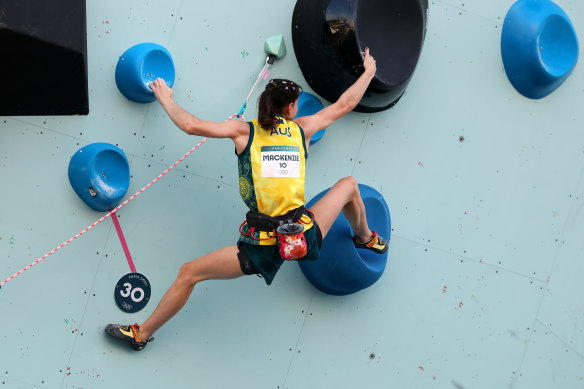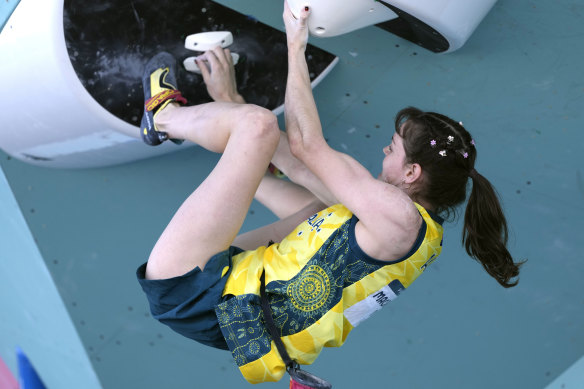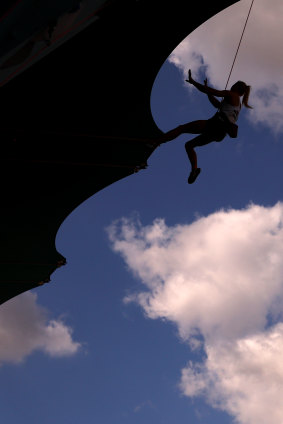Oceania Mackenzie had a medal within her grasp. But she hit the wall
By Greg Baum
Oceania MacKenzie hit the wall.
She charged at it, grappled with it, swung herself up it, dug her toes into it and clung to its indents and projections.

Oceania MacKenzie competes in the Olympic final.Credit: Getty Images
There were more walls, and she attacked those, too. This was the Olympic sport climbing combination final, and she wasn’t going to let the moment go.
Fleetingly, MacKenzie led. In the first section of the combination, unharnessed climbers must puzzle their way along marked routes up four different four-metre high walls, gaining points as they go, but losing tenths of points for each failed attempt. Mackenzie scaled one at the first try.
Another has an overhang of 68 degrees. It asks climbers to go bravely where flies and insects fear to tread. This is the boulder round.
Melburnian McKenzie has been doing this since she was eight. She’s 22 now. This is what she loves.

Oceania MacKenzie comes to grips with the wall.Credit: AP
“I really enjoy how physically and mentally challenging it is,” she said. “You’re almost like solving a puzzle on the wall. In general, you’re always in competition with the wall, and being a very competitive young person, it just sparks me.”
Sport climbing has become a crowd-puller. Put it this way: there were airport-style corrals at the media entry. At the Olympics, it’s still new and a bit out there, but what could be more Olympian than reaching for the heights, failing repeatedly, and reaching again? That’s how the sport works.

Slovenia’s Janja Garnbret of Slovenia falls after her climb,the gold medal already won.Credit: Getty Images
The stands were packed. Mackenzie, who competed in deserted Tokyo, was stoked. “I really like it when the crowd gets behind me and supports me,” she said. “It gives me a little edge.”
In rock climbing, a little edge is both crucial to hold and goes a long way.
After the boulder round, MacKenzie was in the bronze medal position. For a second, she thought about it. “I did,” she said, “but I was mostly thinking of just trying my best and not overthinking, climbing freely.”
In the lead section, climbers one-by-one tackle a wall 15 metres high with seven metres of overhang canted at 42 degrees, which means sometimes climbing almost upside-down. They have six minutes to get as high as they can, fortunately with a belaying rope for when they lose their grip.
It’s high enough that climbers use binoculars to scan its heights during the two minutes they have for observation beforehand. They do this together and convivially, sharing notes. As in most daredevil sports, they’re a community. Only a climber could understand a climber.
It makes for a, well, gripping spectacle. Climbers twist, stretch, reach and cling. Sometimes they leap between holds, sometimes they flatten themselves against the face. At intervals, they pause and perch, chalking their hands and plotting their next move. You can just about hear their muscles scream and feel them burn.
Like mist from a valley, the cream rose. Japan’s Ai Mori, last after the boulder round, was the only one to clamber to the top.
But Slovene Janja Garnbret had them all covered. She climbed as if scaling overhanging cliffs was second nature to her, which it is. Even a layman could only marvel at how closely she cleaved to the face. She won.
Lead is MacKenzie’s lesser discipline. Again, she went at it with all she had. Sport climbing is her go. Yes, there’s feminist literature, and baking and learning Japanese, but first of all there’s climbing. She’s a vegan with not a wasted gram on her frame. Unsurprisingly, she’s aiming high, at least as far as Brisbane.
This day, she willed herself halfway up the wall, to a height that eventually would earn her seventh place. But her forearms were screaming at her, and her lungs, too. “I had a lot of lactic acid build-up by then,” she said, “and I was a little out of breath, too.”
At last, it became too much. Her grip came away from a chalky handhold and she floated away from the face, thankfully attached to a belaying rope, and fluttered to the ground, smiling still.
She’d hit the wall.